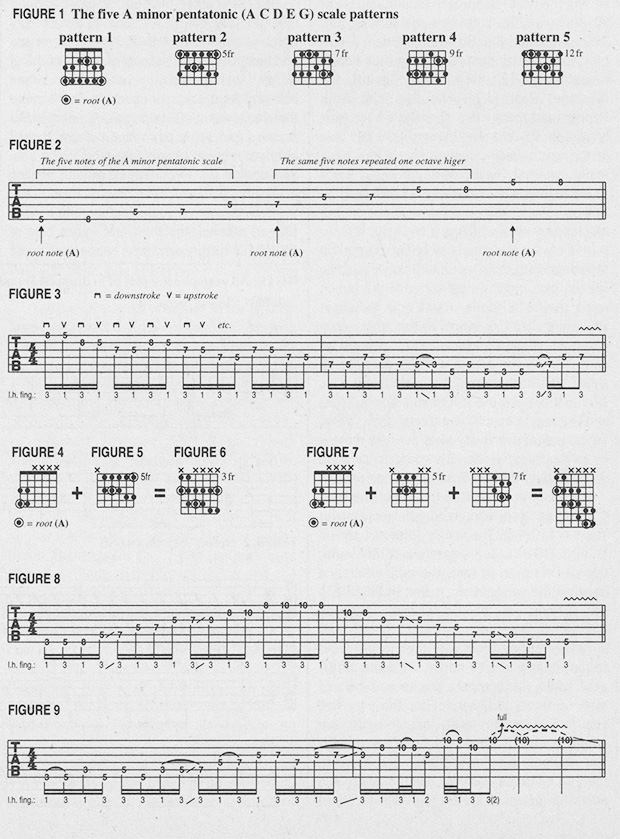Zakk Wylde Lesson: How to Link Minor Pentatonic Scale Patterns
Link a few scale patterns together so you can start making full use of your guitar’s neck when you’re playing a lead.

GuitarWorld.com revisits Zakk Wylde's classic Guitar World column, "Brewtality."
Last time, we kicked off this series of Brewtality columns by going over some basic, but essential, stuff and learning how to play the A minor pentatonic scale (A C D E G) all over the neck. We did this by learning the five fretboard patterns shown in FIGURE 1.
Hopefully you’ve gotten all five of these patterns nailed by now because, like I told you last time, together they form the basic framework that we’re gonna be using to create some pentatonic runs and licks over the next few columns.
In fact, in this installment of Brewtality we’re gonna link a few of these scale patterns together so you can start making full use of your guitar’s neck when you’re wailing out a brewtal lead, instead of just using one “box shape” (scale pattern) all the time, which is a common trap that a lot of players fall into.
Before we get into that, though, I have to tell you something I forgot to explain last time, and that is what the hell “pentatonic” means! Pentatonic is just another way of saying “five tones” or “five notes,” that’s all. So, a pentatonic scale is just a scale made up of five different notes that are repeated in different octaves.
If you play through any one of the A minor pentatonic scale patterns we’ve just learned, you’ll hear what I’m talking about. For example, check out FIGURE 2, which is the second A minor pentatonic scale pattern we learned last month.
As you can see and hear, after the first five notes, the scale starts repeating again; the only difference is that the second five notes are an octave higher than the first five. Now that we’ve gotten that straightened out, let’s start connecting those dots.
FIGURE 3 is a kick-ass run that uses the first two A minor pentatonic scale patterns together in a single phrase. As you can see, what we’ve done here is pretty simple, but it’s definitely effective. We’ve basically added the first four notes of scale pattern 1 (see FIGURE 4) to scale pattern 2 (see FIGURE 5), using finger slides to create the bigger, overlapping fretboard pattern shown in FIGURE 6.
Now let’s take this approach a step further by adding some notes from scale pattern 3. We’ll take the first four notes of scale pattern 1, the notes on the A, D and G strings of scale pattern 2 and the last six notes of scale pattern 3, and combine them, via finger slides, to create an elongated pattern that covers a pretty wide swath of fretboard territory.
FIGURE 7 illustrates the resulting pattern. FIGURE 8 is a run that takes you up and down this new pattern. As you can see, with a couple of two-fret slides on the A and G strings, it takes us from the third fret up to the 10th and back. Notice that I slide up the neck with the ring finger and down with the index finger. It just feels more natural to me to “pull” or “lead” my fretting hand in the direction I’m going, as opposed to “pushing it.”
FIGURE 9 is another A minor pentatonic run that rips though this new scale pattern. Try slamming out some licks and runs of your own using this pattern.

Get The Pick Newsletter
All the latest guitar news, interviews, lessons, reviews, deals and more, direct to your inbox!
“There are so many sounds to be discovered when you get away from using a pick”: Jared James Nichols shows you how to add “snap, crackle and pop” to your playing with banjo rolls and string snaps
Don't let chord inversions bamboozle you. It's simply the case of shuffling the notes around







![Joe Bonamassa [left] wears a deep blue suit and polka-dotted shirt and plays his green refin Strat; the late Irish blues legend Rory Gallagher [right] screams and inflicts some punishment on his heavily worn number one Stratocaster.](https://cdn.mos.cms.futurecdn.net/cw28h7UBcTVfTLs7p7eiLe.jpg)


